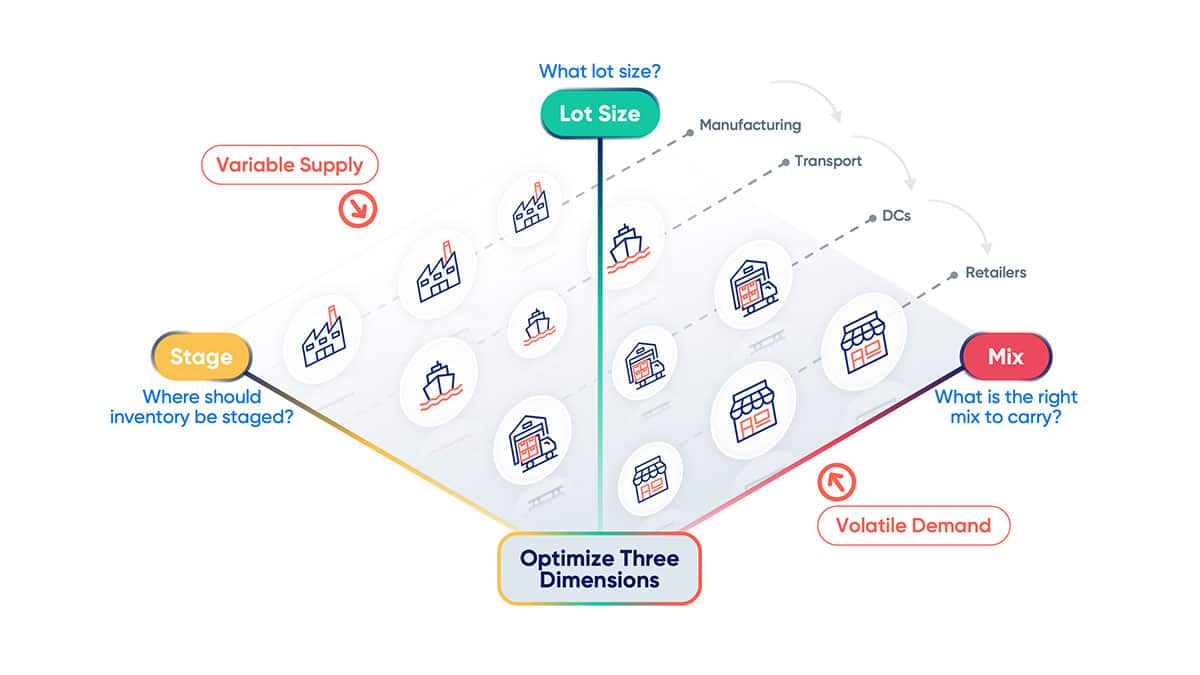Safety Stock – Mastering Demand and Supply Chain Planning
Safety Stock: Navigating Supply Chain Volatility Through Strategic Inventory Planning
Demand volatility represents a critical challenge for supply chain executives today, with safety stock emerging as a key strategic tool to mitigate market uncertainties. Recent tariff policies have intensified these challenges, creating unpredictable shifts in demand planning requirements and increasing market volatility. Higher costs, trade disruptions, and evolving consumer behaviors make maintaining stable supply chains increasingly difficult, underscoring the critical role of strategic safety stock management in maintaining operational resilience.
By strategically positioning safety stock inventory, companies can implement robust supply planning strategies that absorb unexpected demand fluctuations and supply chain disruptions. This approach enables businesses to enhance their overall operational agility and navigate market uncertainties more effectively.
Inventory optimization software enables businesses to maintain optimal levels across the supply chain, absorbing demand.

Why Safety Stock is Essential for Effective Supply Chain Planning
Improving demand forecasting accuracy remains crucial—yet even well-managed companies struggle with accuracy. Rather that depending solely on forecasting improvements, forward-thinking businesses implement advanced inventory optimization software to compensate for uncertainties.
Safety stock serves as a critical buffer against two key factors in supply planning:
- Demand Uncertainty – Effectively absorbs fluctuations in customer demand.
- Forecast Inaccuracy – Strategically offsets errors in predicting future demand.
Through strategic inventory management powered by supply chain planning tools, companies significantly improve customer service levels while maintaining operational efficiency, even when facing unpredictable demand forecasting challenges.
Achieving the Optimal Inventory Mix Through Supply Planning
Not all inventory contributes equally to supply chain performance, and simply increasing stock levels doesn’t guarantee improved service. Without data-driven demand planning software, reactive inventory adjustments typically lead to:
- Excessive expediting and costly rush orders compromising supply chain efficiency
- Overstocking that creates financial and operational inefficiencies in supply planning
- Underperforming inventory falling to meet customer expectations despite demand forecasting efforts
To maintain exceptional service levels profitably, companies must understand volatility’s root causes and plan accordingly with inventory optimization software. As Tim Payne, Research Director at Gartner, emphasizes:
Responding to the customer can be achieved with cost overruns, excessive inventory and firefighting, but to respond profitably means understanding the sources of volatility and planning for them appropriately.”
How Modern Inventory Optimization Software Transforms Safety Stock Management
A strategic approach through inventory optimization ensures that safety stock is positioned strategically to balance cost and service levels. Key benefits for supply chain operations include:
- Improved service levels – Meeting demand without excessive stock through precise demand forecasting
- Enhanced inventory turnover – Reducing waste and inefficiencies through intelligent supply planning
- Optimized stock placement – Aligning inventory with real-time patterns identified by demand planning software
Multi-Echelon Inventory Optimization (MEIO) leverages AI-powered demand planning and modeling software to dynamically adjust safety stock, ensuring an efficient supply chain. This advanced inventory optimization software considers:
- Statistical demand patterns – Accounting for variability and demand forecasting errors
- Supply chain disruptions – Factoring in transportation delays and lead times
- Customer service goals – Ensuring availability without excess inventory through optimized supply planning
Key Trends Driving the Need for Advanced Supply Chain Planning
Several market trends are making inventory optimization software more critical than ever:
Geopolitical Turmoil:
Recent tariff increases of 25% on Canadian and Mexican imports and increased Chinese imports tariffs from 10% to 20% are disrupting industries from automotive to energy and pharmaceuticals. These changes necessitate sophisticated supply planning strategies and inventory optimization software to mitigate risks and ensure production continuity.
Severe Weather Events:
Natural disasters have already caused shortages across critical sectors like automotive and food. With extreme weather events predicted to rise, comprehensive supply chain planning and inventory optimization become essential for securing supply chains. ·
Labor Shortages:
Across multiple sectors, a shortage of skilled labor is hindering production and delivery. Companies must implement advanced demand planning software and inventory optimization software to account for these delays and ensure product availability.
Sustainability Imperatives:
As businesses face mounting pressure to reduce waste and improve sustainability, efficient inventory optimization supported by accurate demand forecasting is critical to minimize overproduction and excess inventory throughout the supply chain.
The Strategic Path to Intelligent Supply Chain Management
While perfect demand forecasting remains an aspirational goal, optimizing inventory buffers through sophisticated supply planning offers an immediate path to improved supply chain resilience. By leveraging AI-driven inventory optimization and demand planning software, companies can significantly boost service levels, reduce operational costs, and adapt more effectively to demand fluctuations.
Is your business leveraging advanced supply chain planning tools for inventory stability? Now is the time to implement a smarter, data-driven approach to demand forecasting and inventory optimization to transform your supply chain performance.







